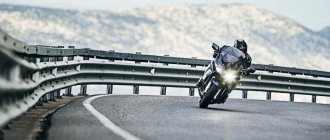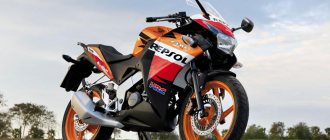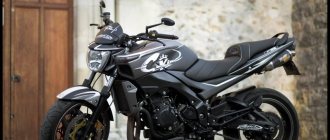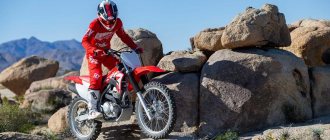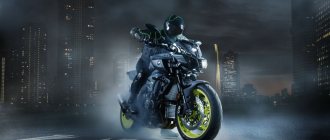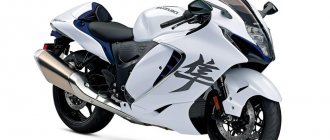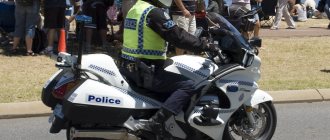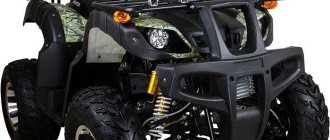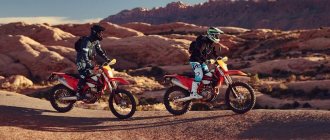HONDA ST1300 PAN EUROPEAN
No one expected popularity from the original ST1100 Pan European from 1990. Honda came out fat, long and heavy, while diametrically opposed qualities were in demand. The neutral color scheme chosen by the Japanese was fundamentally different from the riot of vigorous violet that reigned then. In other words, by all indications, the “tourist” was in for failure and complete oblivion. However, everything turned out exactly the opposite.
“Pan-Europe” was loved. First of all, for its fantastic reliability, ease of maintenance, low maintenance costs and passable driving performance, capable of providing comfort both in everyday traffic and on long runs. Flaws? Where would we be without them? But the owners found recipes to fix them. And manufacturers of accessories did not forget about the “tourist”. And if so, the ST1100 Pan European has become one of the company’s most popular and long-lived models. Need I say what responsibility was imposed on Honda when creating a successor?
STORY
2002 Presented in 2002, the Honda ST1300 Pan European structurally developed the design of the previous generation: a longitudinal v-shaped “four” of liquid cooling, rear wheel drive via a cardan shaft. The displacement increased from 1084 to 1261 cm1, the power rose from 100 to 126 hp, injection and a pair of balancer shafts appeared. The generator moved into the cylinder camber. The camshaft drive is now chain driven. The engine is included in the power structure of the aluminum frame. A 43 mm cartridge “telescope” is installed. A combined braking system is standard, but ABS is an option. But after the appearance of the asphalt “tourist” VFR1200F, the Japanese decided to stop production: the last Pan European left the assembly line in 2016.
The new version of the ST1300, presented in 2002, structurally developed the design of the previous generation: a longitudinal V-shaped “four” with liquid cooling, rear wheel drive via a cardan shaft. The working volume of the engine, which lost cast iron liners, increased from 1084 to 1261 cm3, and it itself acquired injection, as a result of which the output rose from 100 to 126 hp. The generator moved from the crankshaft to the cylinder camber. The camshafts are now driven not by a timing belt, but by a compact chain. A simple, but heavy and insufficiently rigid frame made of steel pipes was replaced by a diagonal frame made of aluminum alloy. The engine is included in its power structure, and in order to reduce the level of vibrations, the motor is equipped with two balancer shafts. Instead of a frail fork with supporting pipes with a diameter of 41 mm, a cartridge “telescope” with 43 mm feathers is installed. The pendulum of the rear suspension is also made of winged metal - it is connected to a monomortizer without an intermediate lever system, and a cardan is hidden inside it. A combined braking system is standard, but ABS is an option.
For those who like to travel, Honda has provided two side cases of 35 liters each, an electrically adjustable windshield and a double gas tank with a capacity of 29 liters (one part of it is located in the usual place, the second is under the saddle). And at the same time, despite the “oversized” dimensions, the weight of the Pan European decreased by 11 kg!
As with the “one thousand hundredth”, the ST1300 appealed to the taste of the target audience around the world (in the USA it was known exclusively by its alphanumeric index) and over the 14 years of production it became known as an easy-to-use and comfortable motorcycle, although not perfect. But time passed. And internal competition with the company’s other road “long-hauler,” the VFR1200F, began to take its toll. So the Japanese decided to retire Pan European after 2016.
A purebred truck driver - and that says it all. Moreover, for a motorcycle that aesthetically resembles an old mainline bus, the Pan European is very fast, comfortable and, surprisingly, agile. The low center of gravity significantly masks its 329 loaded kg, allowing it to perform miracles of balancing act in parking lots and in cramped conditions. Although, of course, all this considerable mass does not disappear anywhere, and therefore, if you suddenly stop on a slope, with your front wheel buried in a wall or curb, you will have to sweat a lot, pushing the elephant back. And on serpentines, Pan European will require a noticeable application of strength. So his path is the high road, where the motorcycle will delight you with smooth and measured reactions.
Short people who prefer to sit closer to the windshield noticed a curious effect when, at high speed, turbulent eddies seem to pull their heads forward into the air vacuum zone, introducing a significant imbalance in the weight distribution of the Pan European. In 2007, Honda recognized the problem and recommended that the heaviest items be placed at the very bottom of the 35-liter side cases and as close as possible to the center of gravity of the motorcycle, distribute the load evenly between both boxes and in no case exceed the maximum permissible luggage weight (no more than 9 kg in each!). The Japanese kept silent about the central trunk with a capacity of 45 liters, but experienced owners advise leaving it at home, and if this is not possible, then installing it only when traveling together (this way there are fewer turbulences behind the driver).
If the Honda V4 was looked after (they did timely maintenance, purchased high-quality consumables, monitored the valve clearances and tensioners of both timing chains), then there is no trick to expect. However, during inspection it makes sense to take a closer look and listen to the engine. Blue smoke from mufflers and a drop in oil level during the service period are a bad sign. There are also noticeable vibrations, but they are not difficult to cure: the reason lies either in out of sync throttle valves or in misaligned balancer shafts.
Alas, old age manifests itself not only in this. Over time, for example, the steel tubes of the cooling system pump cover begin to rust and leak. In addition, the exhaust system clamps rot, which tend to weaken and fall directly under the rear wheel, tearing the tire open like a knife.
Owners of older Pan-Europes encounter problems with second gear everywhere. Therefore, during inspection, it is worth driving, sharply opening and closing the gas in each gear - it should not knock out. But the cardan drive, despite several identified cases of gearbox failure, on the contrary, does not cause any particular problems. Is that because of the frequent removal of the rear wheel and saving on lubrication, it sometimes licks off the splines.
The main electrical problem is moisture. It affects both the wiring harness on the left side (the contacts sometimes rot in five to six years) and the electric windshield drive. Therefore, try not to overuse pressure washing, but at the same time check the condition of the connectors and use special means to protect them (for example, Liqui Moly Electronic-Spray). Such a typical Honda problem as a failing generator also requires attention (the relay-regulator built into it usually burns out first). It is easy to check the functionality of the node. With the engine off, the voltage at the battery terminals should be 12.3-13.2 V, while at 5000 rpm, regardless of whether the headlights are on or not, it should be 15.5 V. Any deviations indicate a problem.
Nissin combination brakes are a thing in themselves: some people like them, others hate them. They work as follows: when you press the lever on the steering wheel, two of the three pistons of the front calipers are activated, and when you press the pedal, the entire rear caliper and one piston on the front caliper are activated. But the complexity of the mechanism and the huge number of different components increase the risk of breakdown and leaks due to aging seals. A lot of headaches are caused, for example, by a strange distribution valve (it determines how much pressure to apply to the front and rear circuits) and a souring secondary master brake cylinder of the left fork caliper. Therefore, make it a rule to service the entire system at every maintenance. The pads should move freely in the calipers along the mounting pins, and there should be no dirt or traces of corrosion on the brake disc rivets that secure the rotor to the hub.
For unscheduled service, Pan European owners were invited to the dealer service three times. The reasons for the recall campaigns were the engine oil pan (due to its poor shape, the original part always clung to curbs and speed bumps), battery wires (the motorcycle could stall at the most inopportune moment) and the hose of the rear brake expansion tank (it clung to a bolt fastening the rear wheel speed sensor wire, which could have rubbed through).
TRANSMISSION
The ST1300 gearbox, especially on early examples, suffers from a falling second gear. Spare parts are relatively inexpensive, but repairs will require dismantling the engine. Therefore, a check before purchase is necessary: when the throttle is suddenly opened and closed, the gear should not be knocked out.
Two side cases of 35 liters each can hold a lot of things. And if you add in the optional 45-liter central one, you might think that Pan European is capable of carrying away the entire house. But this cannot be done for several reasons. Firstly, each of them can withstand no more than 9 kg, and the total load capacity, including driver and passenger, is limited to 196 kg. And, secondly, their excessive and uneven loading can lead to wobbling at high speed.
ELECTRICAL
Electrics suffer from age and moisture. Especially the wiring harness laid to the field side. Therefore, use special products (for example, Liqui Holy Electronic-Spray) to protect contacts and plugs. And avoid pressure washing.
TUNING
The polarity of the ST1300 led to a veritable accessories industry developing around the motorcycle. The most popular modifications include, for example, a front fender extension and rear fender liner, a grille for the radiator, arches to protect the side cases, an additional socket in the glove compartment and a mount for a navigator. Many installations also install spacers under the steering columns in order to raise it by 30 mm without having to worry about replacing hoses. A different windshield is also relevant for Pan European, because the standard one, even despite the electrical height adjustment, causes a lot of criticism.
Tire selection
In the context of tires with the BMW R 1200 RT, everything is crystal clear from the start. 120/70-R17 and 180/55-R17 are some of the most popular sizes. The standard wheel sizes on the ST1300, although rare in themselves, are not unique. Before 120/70–18 it was installed on the Honda CB1000 and X4, as well as on the Yamaha TDM900 and Warrior. As for the rear 170/60-17, it's clearly early 90s with "tourers" like the CBR1000F and GPZ1100, as well as the more recent BMW R 1150 RT. Wheels in these sizes are still produced, and what’s more, there are plenty to choose from.
You need to look among sports and touring models, giving preference to reinforced versions, designated differently by different manufacturers. More specifically, it will be Pirelli Angel GT, Metzeler Roadtec Z8 Interact, Michelin Pilot Road 4GT, ContiRoadAttack 2 EVO GT, Dunlop Roadsmart III. They will be expensive, about 20,000 rubles per set, but will provide excellent grip on both dry and wet asphalt and a long service life.
Those who want to save a little can turn their attention to previous models of sports and touring tires that are still in production. These are Metzeler Roadtec Z6, Michelin Pilot Road 3, Conti Road Attack, Dunlop Roadsmart 2. This group also includes the Korean tires Shinko Verge Radial 011, which can also be put on the “Pan-Europe” due to poverty. Such a kit will cost less, but you will lose grip properties and service life at the same time, so in rubles per kilometer it will be the same. Still, tire manufacturers are making progress, and the difference between different generations of tires from the same manufacturer is strongly felt.
Another way to save money is to install “chopper” tire models. In this size you can find the Metzeler ME880 Marathon and Michelin Scorcher with the Harley-Davidson logo on the sidewalls (Michelin will have the rear wheel size from H.-D. Dyna - 160/70). Such wheels exceed factory requirements in terms of load indices; they are more rigid in their frame and “oak” in composition of the rubber mixture. They last a really long time, but you will have to drive them more carefully - they will not provide grip properties at the level of sports touring tires.
I would dissuade you from installing the more common 180/55 wheel backwards.
Firstly, it does not “mushroom” well on the five-inch rear disc, and as the inclination increases, the contact patch of the rear wheel decreases, and secondly, it is lower than 170/60, which leads to more frequent damage to the disc on bumps and earlier contact of the footpegs with the ground when cornering. So 170/60, no wider needed. www.motorezina.ru Opening up! > April 25, 2022 11:00 Mikhail Pimus
Cost of spare parts and service
If necessary, you can find a lot of parts and spare parts for the Honda St 1300 Pan-European in online stores at fairly affordable prices.
The list includes:
- air filters;
- pistons;
- gaskets;
- temperature sensors;
- water pump seals;
- starter relay;
You can find a lot of parts and spare parts for the Honda st 1300 pan-european.
Similar products can be found at offline points of sale, but buying online is much more profitable.
The average purchase price for a spare part for a Honda motorcycle through an online store will be 2,000-3,000 rubles.
Motor vehicle maintenance is most often carried out by specialized or branded services. The cost of repairing or diagnosing a Honda 1300 Pan-European will depend on the specific breakdown, as well as on the region and authority of the motorcycle dealership.
Available versions
I've chosen to base my reviews on standard cars since they usually sell best and get the most miles, but that's not the case since the "touring" designation comes with optional Anti-lock Braking System (ABS) and the resulting safety.
Honda ST1300 ABS
Honda ST1300 ABS
2009 Honda ST1300ABS
Honda has designed the ST1300 ABS version as a motorcycle equipped with a smart system that combines with LBS (Linked Brake System) for greater control over the brakes and steering. The result is a latest generation system developed by Honda specifically for this type of car.
Competition
2009 Yamaha FJR1300AE
It's quite normal for an ABS version of a motorcycle to compete with the ABS versions of the bike's competitors, and since Yamaha offers the system as standard equipment, that leaves only Kawasaki. With the Concours14 ABS, Kawasaki offers incredible performance plus superb stopping power. As the race between the three continues, we can only be confident and supportive in our expectations for the grand finale, locked wheels are out of the question!
2009 Kawasaki Concours1400ABS
Test Drive
I also had the opportunity to enjoy the ST1300's comfort and handling on the ABS version, and noticed that only the ABS version of the bike was sporty, as I had to press hard on the brake lever and pedal. If you also want to test the braking capabilities of the motorcycle, then you must take into account its size and weight
I recommend choosing a straight road without traffic and then gradually but still firmly applying pressure to the brakes until you get used to the bike's response and feel. After several attempts, you can try them to their fullest and see how ABS works on a motorcycle.
Price
Everything comes at a price and Honda ensures that the ST1300 ABS model is still affordable while offering the best braking system. The bike has a MSRP of $14,599.
Translation from English MotoSvit
Competition and comparison
If you look at the tourists of the motorcycle world who are closest in class and characteristics, then the stylish BMW R1200RT immediately comes to mind.
Without a doubt, it can be classified as a luxury motorcycle. In the production of this model, BMW focused on status and presentable appearance. Although I didn’t forget about the functionality - more than one additional gadget was introduced on the p1200rt.
The standard package includes:
- automatic windshield adjustment;
- powerful audio system;
- built-in navigation;
- temperature control and much more.
However, there are some areas where the R1200rt is inferior to the Honda Pan Europe 1300. The most obvious is the price. The maximum price tag for a BMW bike can exceed one million rubles.
As for the characteristics, the engines of both motorcycles are almost identical in terms of volume and power. The same applies to reliable brakes and a strong body.
If desired, more detailed characteristics of the BMW R1200rt can be found by viewing the review of this model.
The motorcycle has a reliable braking system
Driving features
Acceleration to hundreds
The mile time is 11.9 seconds, which is excellent for a bike in this weight class.
A special part of the motorcycle is the braking system.
Fuel consumption
The consumption of this model is 5.2 liters per 100 km. The oil tank can be filled to 4.7 liters.
Brakes
The brake system is a special part of a motorcycle. Discs are installed both front (310 mm) and rear (240 mm). The engineers also added an ABS combined braking system to the Panochka, which is undoubtedly a plus.
Specifications
The developers explained that if the belt breaks, you can drive further.
The gears are designed to operate independently. Otherwise, the bike did not receive any special solutions. A 4-cylinder, 4-stroke engine was installed on it. The engine is deployed across the frame, and the clutch is located in the front part.
The arrangement of the pistons is V-shaped, the angle between them is 900. It gave:
engine, the following parameters:
- working volume - 1085 cm3;
- power - 100 (98) hp;
- number of valves - ;
- cylinders - ;
- cooling - liquid;
- fuel supply - carburetor (Keihin, 32 mm);
- ignition - transistor;
- start - electric starter;
- fuel tank - 28 l.
To comply with European traffic safety laws, the Japanese slightly throttled the engine. The bikes sent to America had 100 mares “under the hood”. European - 98 hp The Japanese cheated - the engine remained at the same power. Light tuning increased torque, but decreased power.
Transmission and clutch
Gear shift pedal.
The gear ratios were chosen in such a way that the first few gears had to be changed frequently, but once in third, you could ride further like on a scooter - adjusting the speed only by turning the throttle. It varied widely from 17 to 170 km.
But users noted one feature. It is not recommended to turn up the speed in the first gears, otherwise the next ones will turn on poorly - ultimately repairing the gearbox.
- The clutch is standard - multi-plate, oil bath.
- Drive - cardan shaft.
Brakes
Front brakes:
- number of disks - ;
- diameter - 296 mm;
- support - 2-piston (since 1995 - 3).
Rear brakes:
- number of disks - ;
- diameter - 296 mm;
- support - 2-piston (since 1995 - 3).
In 1995, the motorcycle received combi-brakes. For proper functioning, an additional, third piston appears on each bracket.
Model range and modifications
Honda ST1300A Pan-European
In fact, this is the same Honda St1300 Pan-Europe, which has been officially sold since 2013 for Russia.
Honda NC 700 X
A more budget option, with a high seating position, while maintaining good dynamics and comfort for the driver.
Specialized or branded services most often provide maintenance for motorcycles
Honda ST1100 Pan European
A veteran of motorcycle tourists, who left production at the beginning of the 2000s. It was replaced by the ST1300 model.
Honda PC 800 Pacific Coast
Quite an old Honda tourer model, released back in the 80s. In terms of technical parameters, it cannot compete with its young “brothers”. At one time, the media ironically dubbed this bike a “huge scooter.”
Honda ST 1300 ABS
A modified version of the Pan1300 Europe with a built-in ABS brake system, produced since 2009.
Model history
2002 - start of production and sales. Models with ABS have an electrically adjustable windshield Model: Honda Pan-European 1300 + ABS (Europe). Factory designation: ST13002, ST1300A2.
2003 - no significant changes. Model: Honda Pan-European 1300 + ABS (North America, Australia). Factory designation: ST13003, ST1300A3.
2004 - Electrically adjustable glass is included as standard equipment. ABS is standard in most countries. Model: Honda Pan-European 1300 + ABS (Europe, North America, Australia). Factory designation: ST130043, ST1300A4.
2005 - appearance of the police modification ST1300. Model: Honda Pan-European 1300; Honda Pan-European 1300 Police (North America). Factory designation: ST1300A, ST1300A A; ST1300P5, ST1300PA5.
2006 - no significant changes. Model: Honda Pan-European 1300; Honda Pan-European 1300 Police (Europe, North America). Factory designation: ST13006, ST1300A6; ST1300PA6.
2007 - no significant changes. Model: Honda Pan-European 1300; Honda Pan-European 1300 Police (North America). Factory designation: ST1300A, ST1300A A; ST1300PA7.
2008 - no significant changes. Model: Honda Pan-European 1300 (Europe, Australia, Asia). Factory designation: ST13008, ST1300A8.
2009 - no significant changes. Model: Honda Pan-European 1300, Honda Pan-European 1300 Police (Europe, Australia, Asia, North America). Factory designation: ST13009, ST1300A9; ST1300PA9.
2010 - no significant changes. Model: Honda Pan-European 1300 (North America). Factory designation: ST1300A, ST1300A A.
2011 - no significant changes. Model: Honda Pan-European 1300 Police (North America). Factory designation: ST1300PAB.
2012 - no significant changes. Model: Honda Pan-European 1300; Honda Pan-European 1300 Police (North America and others). Factory designation: ST1300AC; ST1300PAC.
2013 - no significant changes. Model: Honda Pan-European 1300; Honda Pan-European 1300 Police (North America and others). Factory designation: ST1300AD; ST1300PAD.
2014 - no significant changes. Model: Honda Pan-European 1300; Honda Pan-European 1300 Police (North America, Europe and others). Factory designation: ST1300AE; ST1300PAE.
2015 - no significant changes. Model: Honda Pan-European 1300; Honda Pan-European 1300 Police (North America, Europe and others). Factory designation: ST1300AF; ST1300PAF.
2016 is the last year of production. Model: Honda Pan-European 1300; Honda Pan-European 1300 Police (North America, Europe and others). Factory designation: ST1300AG; ST1300PAG.
Appearance and dimensions
Honda Pan 1300 has quite standard dimensions for a vehicle of this type.
The motorcycle is 2.27 meters long, almost 0.9 meters wide and 1.4 meters high. The wheelbase is 1490 mm.
The gas tank capacity is 29 liters (including a five-liter reserve).
As for the appearance, it is quite laconic. The ergonomic design of the bike will not leave true motorcyclists indifferent.
The capacity of the model 1300 Pan Europe is two people, a driver and a passenger.
Quite low seating position, which provides driving comfort and a better feeling of the road.
